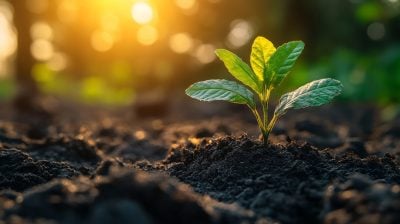How can Africa achieve its Green Revolution? Neil Ford examines the various strategies, from government policy to innovations, which must be put in place if the continent is to finally achieve its long-sought dream of becoming self-sufficient in food.
Throughout human history, rapid changes in agricultural production have been required to enable more general economic development. From Ancient Mesopotamia to the UK’s emergence as the first industrial nation, more efficient agricultural practices have enabled ever smaller numbers of people to grow most of the food, leaving a growing proportion of the population able to undertake other activities, from manufacturing and industrial development, to health care, education and the arts.
While many Africans continue to spend most of their working lives growing food for their own consumption, they do not become engaged in other economic activities. A step increase in agricultural production is required to ensure that the number of people working in agriculture can fall at the same time that populations grow through high fertility rates. Crop yields in Africa currently average about one tonne per hectare, compared to seven tonnes in Western Europe and North America.
Existing and innovative technologies need to be implemented to enable such a jump in output, including greater mechanisation and irrigation, financial support, more fertilisers, and higher yielding and more pest-resistant seed varieties.
With many African governments now much more interested in promoting agriculture, the Alliance for Green Revolution in Africa (AGRA) is leading the way in seeking to cultivate an African green revolution
Improved strains
At present, many farmers merely save part of their annual harvest to re-use as seed, rather than buying higher yielder strains. The proportion of farmers in northern Kenya who buy seed to plant is estimated at just 10%.
However, the number of seed producers and distributors across the continent is growing, often as a result of deregulation that allows private companies to compete for customers. More than 70 firms, including Freshco of Kenya, are supported by AGRA. Training in crop management is also required to ensure that farmers make the most of the resources available to them. Some, particularly in North America, suggest that African farmers should leapfrog the Green Revolution as experienced in India and Brazil, and move straight on to genetically modified (GM) crops.
Others argue that the focus on GM increases dependence on biotech firms. However, it is vital that crops such as corn and rice, which are dependent on plentiful supplies of water, do not totally displace more drought-resistant crops, such as millet. There are real dangers in concentrating on the cultivation of just a handful of crops, particularly from disease. In the late 1970s, the mealy bug devastated cassava production in Central Africa. Crop diversity supports food security.
Too much African land is degraded and acidic but fertilisers can help to increase yields on existing arable land and also bring more land into production.
Fertilisers
It is estimated that sub-Saharan Africa holds more than 50% of the world’s unused potential arable land. Namanga Ngongi, the former president of AGRA, believes that there are two main elements to the Green Revolution.
He says: “If you’re able to have good seed and appropriate fertiliser, and on time, I think really the production side of agriculture would probably be resolved.”
However, the environmental lessons of the industrialised world over the past 50 years suggest that intensively chemical-fed agriculture is not the only way to achieve higher yields and income. Organic produce can often be marketed internationally at a premium.
Mechanisation
Most farmers in sub-Saharan Africa continue to plant seed by hand, remove weeds by hoe and harvest crops by hand or with secateurs.
Even simple tools such as ploughs can improve efficiency and while tractors can provide a step increase in the amount of land that can be worked by a single person, it is vital that spare parts and maintenance are available locally. Cooperative use of expensive machinery is often the best option.
Irrigation
The lack of reliable rainfall is one of the biggest obstacles to bigger yields in Africa. Irrigation can take simple forms, including small ditches or drills to distribute water evenly, up to grand schemes based on reservoirs.
Many of the huge hydro schemes under development in Ethiopia at present encompass irrigation projects as well as power generation. Predicting future rainfall patterns is notoriously difficult but most projections suggest that precipitation could become even more unpredictable in Africa over the coming decades as a result of climate change.
Financial support
Government financial support for the agricultural sector can take many forms, including investment in research and development, backing for marketing companies and direct subsidies.
Malawi has provided a rather controversial example in recent years. Going against advice from international financial institutions, the government introduced generously subsidised fertiliser and improved seed strains in 2006.
As a result, it was transformed from being reliant on food aid into a net food exporter that was able to help neighbouring countries during subsequent food crises. However, many argue that subsidies encourage inefficient farming practices. Indeed, many governments have previously offered guaranteed prices for both food and non-food crops, including cotton, coffee and cocoa, with mixed results.
Marketing
A green revolution does not have to mean the end of smallholding. Small-scale producers, who comprise 80% of all African farmers, can come together to form cooperatives to jointly purchase new seed varieties and equipment, while also marketing their produce as a group.
AGRA has called for “a uniquely African green revolution, one that places smallholder farmers first, which protects biodiversity, promoting sustainability and advancing prosperity”.
Established cocoa marketing bodies in Ghana and CÔte d’Ivoire can provide a model for cooperative smallholder marketing.
Gender equality
Greater focus must also be given to gender equality. Largely as a result of cultural traditions, women comprise about 80% of all African farmers.
Too many people, largely women, work to produce low yields of basic foodstuffs, such as cassava and millet, to feed their own extended families. Improved access to microfinance could enable them to grow other crops for sale in addition to their staple foodstuffs.
Improved land tenure
There is little tradition of documented land ownership in some parts of the continent and small-scale farmers are reluctant to invest in irrigation if their land could be taken away from them.
In some areas, there are problems regarding land ownership by women. In the Ethiopian Highlands, Burundi and Rwanda, plots of land are often divided between the owner’s children. This leads to the creation of ever smaller plots of land as the population grows.
Political and economic security
Farmers in the Pool Region of Congo-Brazzaville, for instance, have been reluctant to buy new machinery because armed conflict has seen crops seized or destroyed over the past 15 years.
The continued but erratic improvement in political stability across the continent as a whole should encourage more farmers to put more effort into improving their yields, buying new machinery and constructing irrigation systems.
Region-specific research
It is vital that the appropriate seeds, fertilisers and other forms of support are developed for each cultural and environmental location. The proportion of agricultural research and development being carried in African institutions is steadily increasing, improving the chances of success for any particular project.
USAID estimates that agricultural research in sub-Saharan Africa generates a return on investment of $25 for every dollar invested.
Dietary changes
Another factor that is growing in importance is the balance between animal and plant-based foods. The rapidly growing African middle classes are increasingly turning to an often unhealthy, Western-style diet that is high in dairy and animal fats. It takes far more land to produce, for instance, 1,000 calories of meat or dairy produce than fruit, legumes or vegetables. Crops that are currently fed to livestock can be replaced by crops that can be directly consumed by people.
In some instances, it can take 10 times as much land to generate the same amount of calories and protein from beef as from beans. Increasing numbers of North Americans and Europeans are turning away from meat and dairy produce but the trend has had little impact among more wealthy people on the African continent as yet. However, ensuring that the proportion of plant produce in the average African diet remains high will increase the calorie yield per hectare.
Want to continue reading? Subscribe today.
You've read all your free articles for this month! Subscribe now to enjoy full access to our content.
Digital Monthly
£8.00 / month
Receive full unlimited access to our articles, opinions, podcasts and more.
Digital Yearly
£70.00 / year
Our best value offer - save £26 and gain access to all of our digital content for an entire year!

 Sign in with Google
Sign in with Google 





